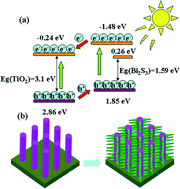Abstract: We firstly fabricated a peculiar 3D structure of Bi2S3 salix leaf-like nanosheet/TiO2 nanorod branched heterostructure arrays by a convenient hydrothermal method and discussed their mechanism of improving photoelectrochemical cell (PEC) properties. The salix leaf-like Bi2S3 nanosheets (NSs) were grown on TiO2 nanorod arrays through controlling the molar ratio of EDTA-Na-2/Bi3+ and the reaction time. The morphology, crystal structure, microstructure and optical performance of the 3D Bi2S3 NS/TiO2 NRs at different reaction times were investigated. The results show that the branched heterostructure of 3D Bi2S3 NS/TiO2 NR arrays exhibits enhanced photocurrent density and optical absorption, which were attributed to the larger Bi2S3 surface area, as well as a direct electron path within the salix leaf-like Bi2S3 NS and TiO2 NR heterojunctions, resulting from more excitation sites of incident light. The photocurrent density of the 3D Bi2S3 NS/TiO2 NR arrays was almost 9 times greater than that of pristine TiO2 without a branching structure. The results of the present work demonstrate that fabrication of the branched Bi2S3 NS/TiO2 NR heterogeneous structure is a significant fabrication technology with great promise in PECs. KeyWords Plus: SENSITIZED SOLAR-CELLS; TIO2 NANOTUBE-ARRAYS; ATOMIC LAYER DEPOSITION; EPITAXIAL-GROWTH; NANOWIRE ARRAYS; THIN-FILMS; CDS; EFFICIENCY; HETEROJUNCTION; PERFORMANCE Published in CRYSTENGCOMM, 18 (9):1577-1584; 10.1039/c5ce02252e 2016 
|

